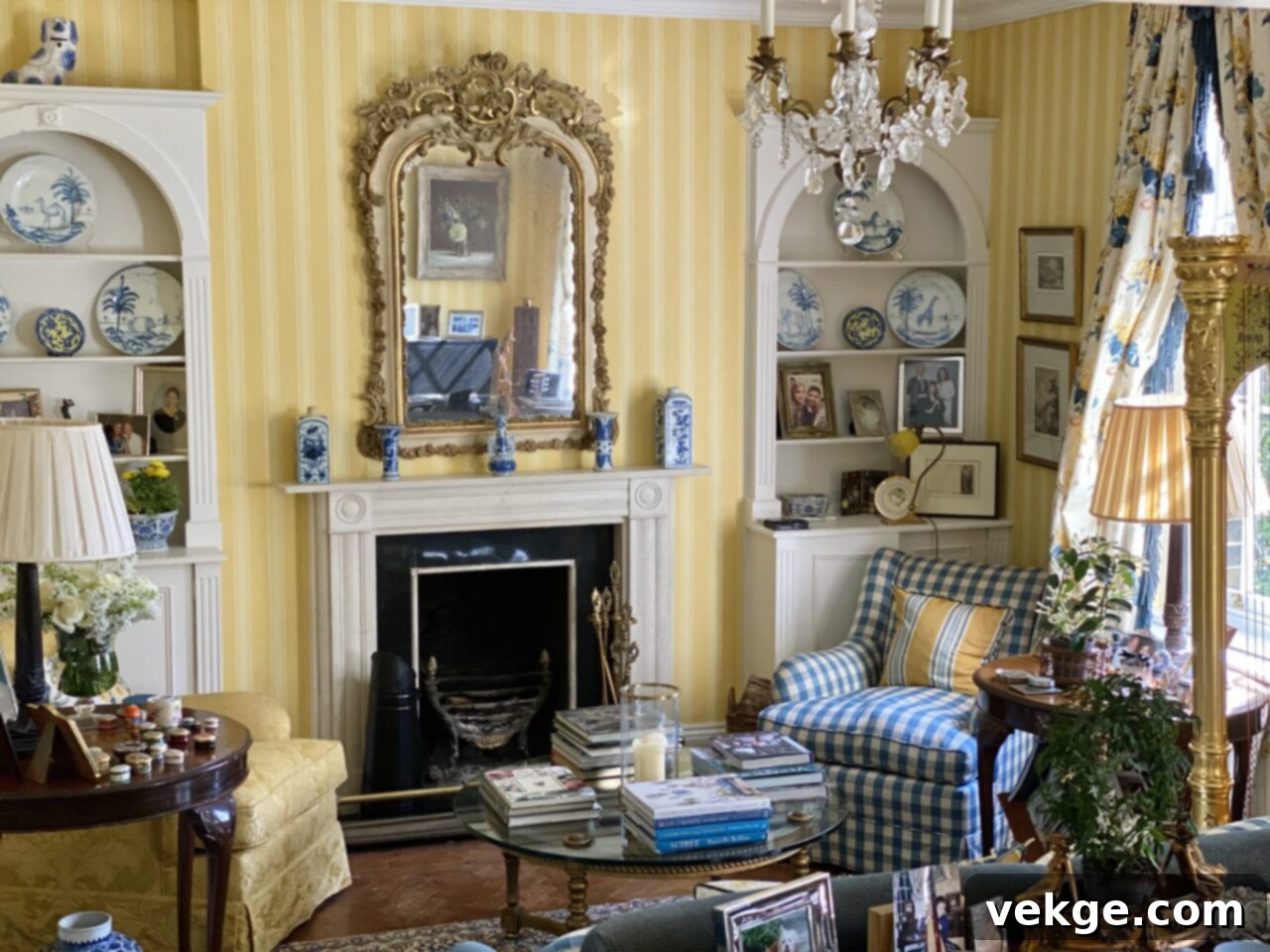The Enduring Allure of English Country Decor: A Timeless Guide to Cozy and Elegant Homes
There’s an undeniable charm that captivates us when we gaze upon the opulent yet inviting interiors depicted in beloved period dramas, from the stately homes of Pride and Prejudice to the grand estates of Bridgerton. While the lavish, castle-esque furnishings of the polished upper class might seem impossibly expensive and out of reach, the more approachable and equally captivating world of English country decor offers a delightful alternative. This distinctive style brings a sense of grandeur and timeless appeal that transcends Great Britain, making it a globally cherished aesthetic.
Before you lose yourself entirely in dreams of sinking into plush armchairs within a magnificent antique library, it’s worth pausing to consider a few crucial aspects. While the English country style might initially strike you as perfectly tasteful and steeped in history, is it merely a relic of the past, or does it genuinely hold contemporary relevance? Is this classic country aesthetic still a trending force in modern interior design? To truly understand the enduring popularity and unique appeal of English country decor, read on as we explore its rich history, defining characteristics, and lasting impact.
A Glimpse into the History of English Country Decor

While English country decor often feels intrinsically British, its origins are somewhat surprising, leading some to consider it an “invented history.” Contrary to popular belief, the distinct look of English country interiors wasn’t born purely from centuries of British tradition. It truly began to take shape and gain definition through the visionary work of Nancy Lancaster, an American decorator. In the mid-20th century, Lancaster took the helm of the esteemed English interior decorating firm Colefax and Fowler. Her influence marked a pivotal moment, as she passionately advocated for integrating modern amenities and a profound sense of comfort into England’s traditionally grand and often austere stately homes.
Following Lancaster’s foundational work, another hugely influential decorator, Robert Kime, further cemented the timeless appeal and widespread success of the style. Kime brought a grander, yet still deeply personal, aspect to historically significant houses by expertly incorporating genuine antiques and pieces with rich narratives into the design. His celebrated work on Clarence House for Prince Charles (now King Charles III) played a significant role in elevating English country decor to a position of widespread popularity and reverence, showcasing its elegance and lived-in charm on a prominent stage.
Why Does English Country Decor Remain an Enduring Aesthetic?

At first glance, English country decor might appear to be a charmingly haphazard collection of items, but its true beauty lies in the careful curation of pieces gathered from diverse sources over time. This means thinking beyond perfectly matching sets of sofas and armchairs; instead, embrace the idea of distinct pieces that complement each other. The authentic warmth and personality of an English country room emanates from its thoughtful layering of textures, patterns, and objects, each telling a part of a larger story.
While not everyone has access to genuine antiques or inherited wealth, the essence of English country decor lies in acceptance and clever improvisation. The goal isn’t always strict authenticity, but rather capturing the spirit of comfort and collected beauty. You can start with subtle changes: choose floral patterns for new upholstery, integrate a vintage-inspired two-tone pink and green bedspread, or simply display treasured books. Even small alterations can set your home on the path to this inviting aesthetic. English country decor continues to thrive amidst countless fleeting trends precisely because its core is rooted in profound comfort and a philosophy of welcoming living. Let’s delve into the key reasons behind its enduring appeal:
1. A Harmonious Mix of Old and New
At the very heart of English country style is a profound acceptance of imperfection—a celebration of items that are chipped, faded, or beautifully worn. This philosophy creates a welcoming environment where every piece, regardless of its age or origin, is embraced. Unlike rigid design rules that demand uniformity, English country decor thrives on accumulated layers of cherished old treasures alongside thoughtfully integrated new items. It’s about building a space that tells a story, where antique heirlooms comfortably sit beside modern art, and contemporary lighting illuminates a centuries-old wooden chest. This juxtaposition creates a dynamic, lived-in feel, reflecting the inhabitants’ journey and tastes, rather than adhering to a strict, momentary trend. This blending of eras results in unique character that is both sophisticated and inviting.
2. The Beauty of Embracing Timelessness
To truly integrate English country decor into modern homes, one must appreciate its inherent evolution and flexibility. This style champions a ‘no rules’ approach, contrasting sharply with trends that demand constant updates. English homes traditionally embrace an indoor-outdoor lifestyle, and with it, an acceptance that furniture and walls may acquire a gentle patina over time. The timelessness stems from this authentic understanding that not every fleeting trend needs to be followed. Your home can be free of gimmicks, filled with beloved odds and ends, and still possess an undeniable sense of elegance and fashion. This reverence for history and practicality over transient fads ensures the style remains perennially chic, allowing spaces to age gracefully and become richer with each passing year.
3. Thoughtful Inclusion of Antiques and Vintages
A significant characteristic of English country decor is its deep appreciation for antique designs and vintage pieces. In contrast to many modern decor styles that might deem them too archaic for contemporary settings, English country style celebrates their unique charm. Vintage wallpapers, classic paintings, and well-loved furniture pieces that some might find “oppressive” are, in this aesthetic, cherished for their history and individuality. This style encourages you to break free from conventional rules, inviting you to bring in items that genuinely bring you joy and infuse your space with personality, regardless of their age. These historical elements ground the home, adding layers of narrative and visual interest that are impossible to replicate with purely new items. Flea markets, estate sales, and even family heirlooms become invaluable sources for achieving this look.
4. A Comfort-Driven Approach to Living
Considering the foundational elements of English country decor, its sustained popularity is entirely understandable. When the primary aim of any interior style is comfort, people will naturally gravitate towards it. Step into an English country-style living room, and you’ll find deep, generously sized sofas and armchairs, often upholstered in tactile fabrics like velvet, linen, or chintz. Abundant throw pillows and blankets beckon you to sink in and relax. This design philosophy creates multiple ‘comfort zones’ within a single room – a cozy window seat for reading, a deep sofa for conversation, or a chaise lounge for an afternoon nap. Soft, diffused lighting from numerous lamps, rather than harsh overhead fixtures, further contributes to a warm, enveloping atmosphere. The overall impression is one of relaxed elegance, a space thoughtfully designed for genuine living, unwinding, and rejuvenation.
5. Reading Materials as Essential Decor
Beyond plush seating, reading materials are an indispensable element that defines the English country aesthetic. Much-loved books aren’t just for reading; they are to be proudly displayed on coffee tables, meticulously arranged on shelves, or stacked invitingly on side tables. This emphasis on books speaks to a return to simpler, more contemplative times, where a good book was often all one needed to spend a delightful evening. This fosters a sense of intellectual warmth and personal history, turning a room into a quiet sanctuary for thought and relaxation. Creating dedicated reading nooks, complete with a comfortable chair, a soft blanket, and good lighting, is a hallmark of this inviting style.
6. Embracing Nature with Florals and Botanicals
The English country home deeply connects with its natural surroundings, often bringing the outdoors in through an abundance of floral and botanical motifs. Chintz fabrics, renowned for their intricate flower patterns, are a quintessential element, gracing everything from curtains and upholstery to cushions and lampshades. Beyond patterns, fresh flowers from the garden are frequently displayed in charming vases, adding life, color, and fragrance. Botanical prints, framed art depicting flora and fauna, and even potted plants contribute to this organic, vibrant feel. This constant interplay with nature creates a lively yet tranquil atmosphere, making the home feel like a natural extension of a beautiful English garden.
7. The Power of Layered Textiles and Rich Patterns
English country decor masterfully employs a variety of textiles and patterns to create its signature depth and visual richness. It’s a style that champions layering – from luxurious velvet cushions atop a linen sofa, to a wool throw draped over an antique chair, and patterned curtains framing a window. Floral chintz is iconic, but it’s often combined with stripes, plaids, checks, and even subtle geometrics, all in a harmonious, collected fashion. This thoughtful mixing of patterns adds texture, warmth, and a sense of accumulated history to a room, preventing it from feeling stark or uninviting. Each layer contributes to the overall feeling of opulence and comfort, inviting touch and extended relaxation.
How Does English Country Decor Differ from Modern Farmhouse?

While both modern farmhouse and English country decor are celebrated for their inviting comfort and homey feel, several key distinctions set these two beloved styles apart. In a modern farmhouse-inspired home, the primary focus often lies on the practicality and unpretentious functionality of each item. The interior aesthetic typically leans towards simpler forms, emphasizing clean lines and a classically American silhouette. Achieving the right weathered and lived-in look, often through distressed woods, natural textures, and a predominantly neutral color palette, is central to nailing a good farmhouse decor. Simple, rustic homes with an airy, comfortable vibe define the farmhouse charm.
Conversely, the underlying philosophy of English country decor places a greater emphasis on collected beauty, history, and a touch more formality. Here, the “simple” elements of farmhouse are often replaced with “ornate,” and “rustic” transforms into “antiques.” While farmhouse embraces a palette of whites, grays, and natural wood tones, English country revels in richer, deeper colors – think jewel tones, deep greens, warm reds, and vibrant floral patterns. At first glance, the rooms might appear to be an eclectic mix of mismatched items, but they are, in fact, meticulously and lovingly curated over time. English country homes feature more intricate details, such as carved wood, brass hardware, and a heavier reliance on patterned textiles like chintz and tartan, creating a more layered, visually rich, and often more formal, yet still incredibly cozy, atmosphere.
Wrapping It Up: The Timeless Appeal of English Country
When we envision English country decor, our minds often wander to the classical elegance immortalized in the works of Jane Austen. While the grand, sprawling estates of that era may no longer be within the average budget, the essence of English country style remains profoundly prevalent and desirable today. The enduring reason behind its immense popularity lies in its unique blend of aesthetic beauty, historical richness, and unparalleled comfort.
Visionary designers like Nancy Lancaster and Robert Kime were instrumental in refining and popularizing the concept of English country decor, transforming it into the beloved style we recognize today. Yet, it is the core elements embedded within every nook and cranny of this aesthetic – the harmonious mix of old and new, the acceptance of imperfection, the celebration of antiques, and a deep-seated commitment to comfort – that truly inspires its countless admirers and ensures its lasting legacy. It’s a style that invites you to build a home with a soul, a place that feels deeply personal, welcoming, and undeniably chic, transcending fleeting trends to offer genuine, timeless elegance. We invite you to share your thoughts on the enduring popularity of English country decor in the comments below!
